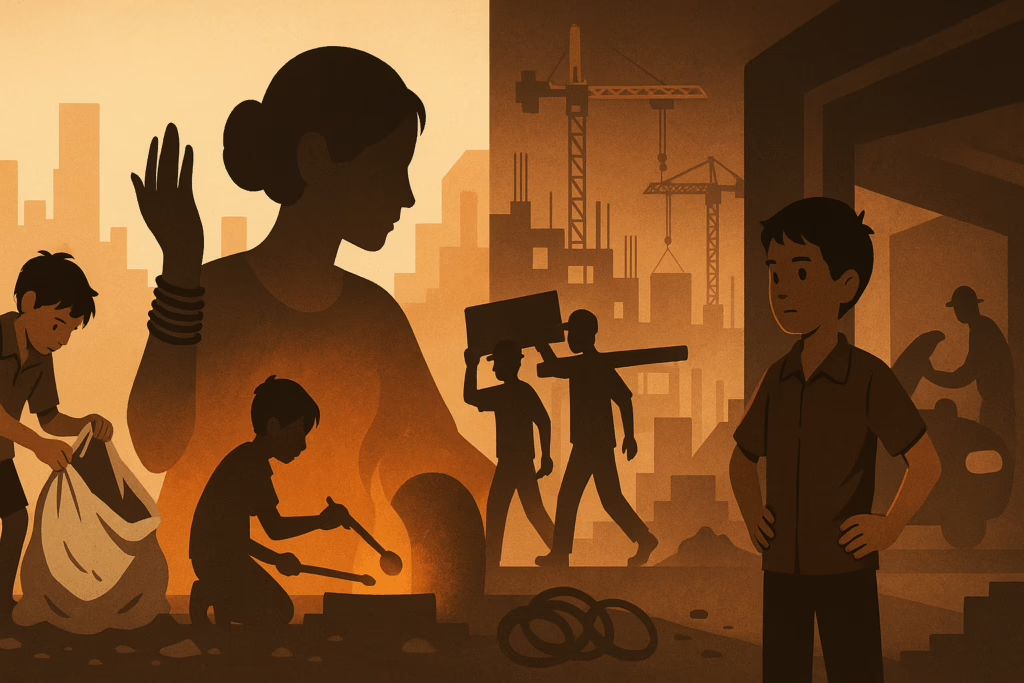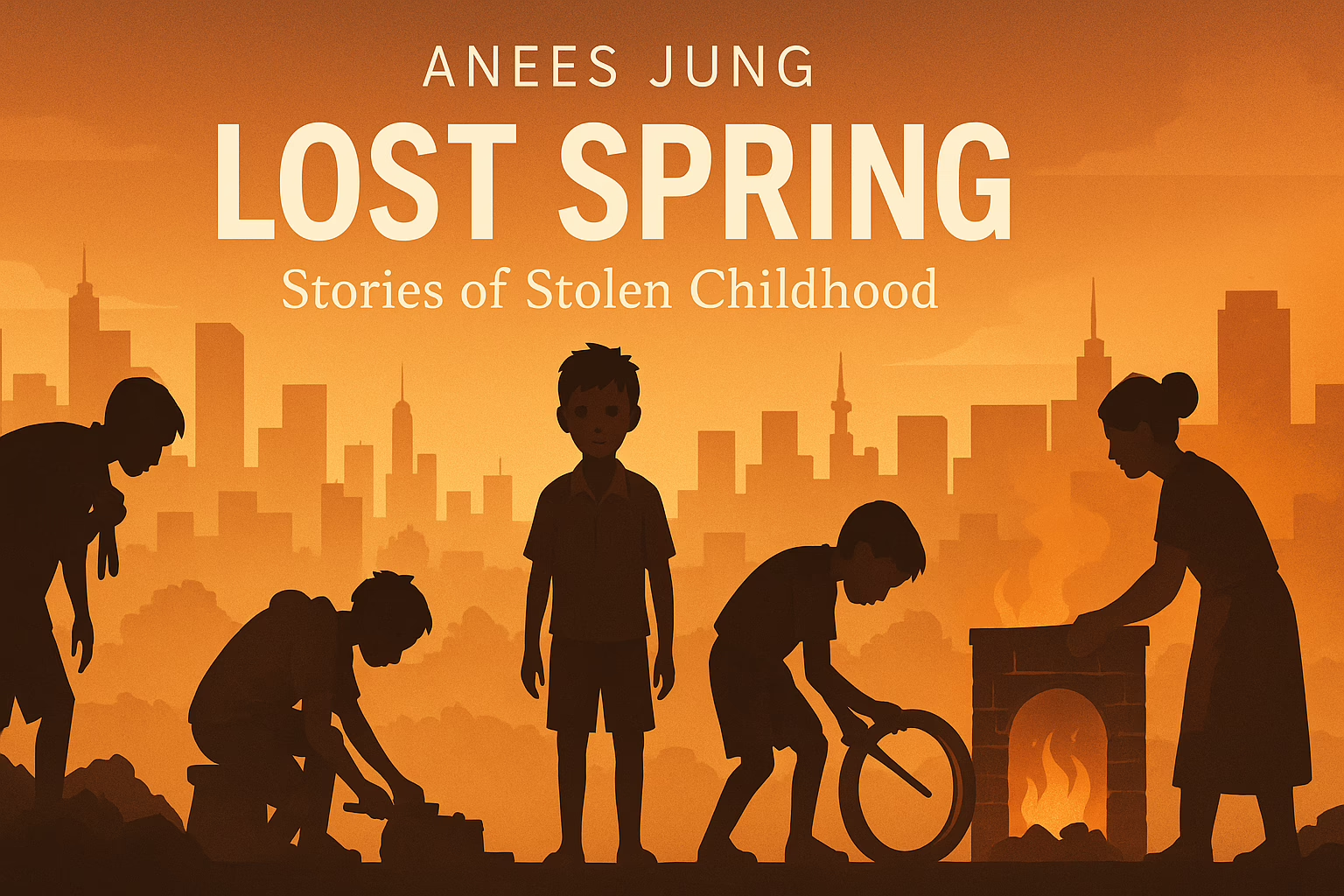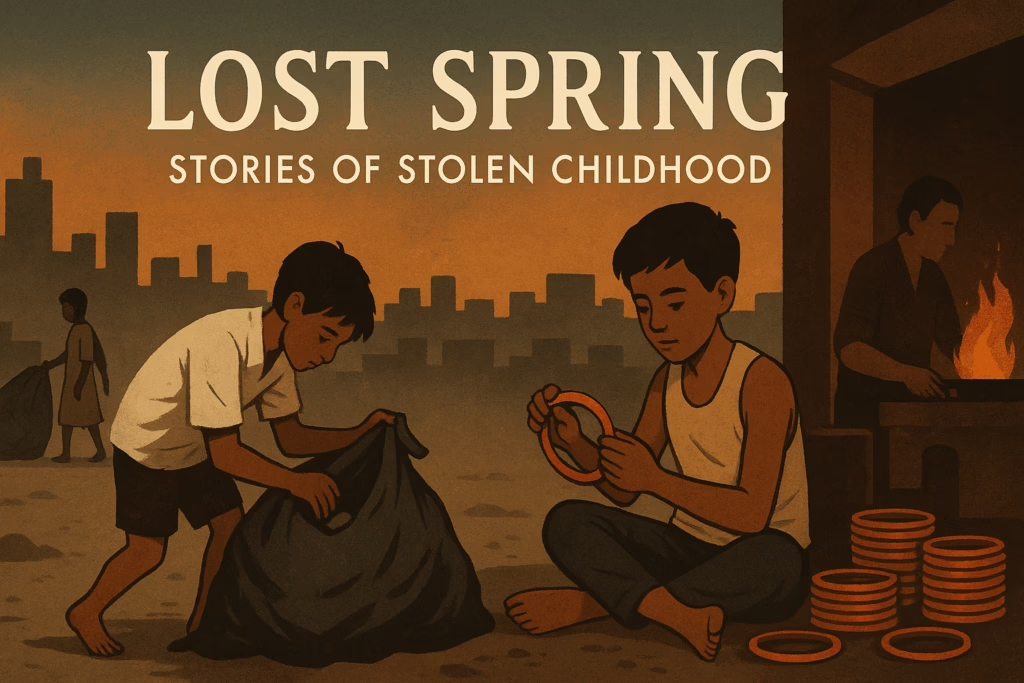Anees Jung’s Lost Spring: Stories of Stolen Childhood is a deeply moving account of the harsh realities faced by children forced into labour and denied even the simplest gifts of childhood—education, play, comfort, and dreams. Through the stories of Saheb, a young ragpicker in the slums of Seemapuri, and Mukesh, a bangle-maker from Firozabad, the chapter reveals the suffocating grip of poverty, tradition, and systemic injustice that binds generations of families. The text serves as both a social commentary and a literary exploration, blending stark facts with poetic imagery.
To help students understand the chapter thoroughly and prepare confidently for examinations, this article offers a comprehensive set of additional questions and answers—including short responses, long analytical answers, HOTS questions, extract-based questions, and value-based discussions. These questions aim not only to strengthen comprehension but also to build critical thinking, empathy, and a deeper awareness of the socio-economic issues that shape the world of these children. By engaging with these questions, learners can appreciate the thematic depth of Lost Spring while sharpening their exam readiness.
You can find a brief summary of the text along with the textual questions and answers in the previous article.

A. Short Answer Questions (2–3 marks)
1. Why does the author call garbage “gold” for the ragpickers?
The author calls garbage “gold” because it serves as the only reliable means of survival for ragpickers, who often find coins, sellable objects, or recyclable materials in it, allowing them to earn money and feed their families.
2. What does the author mean when she says “survival in Seemapuri means rag-picking”?
The author means that in Seemapuri, rag-picking is not just a job but the central activity that keeps the entire community alive, as it is the only work available to the migrants who depend on it for food and bare survival.
3. What differences exist between the dreams of Saheb and Mukesh?
Saheb dreams of going to school or playing tennis, but his dreams remain vague and unfulfilled due to his extreme poverty. In contrast, Mukesh has a clear and determined vision of becoming a motor mechanic, and he is willing to take concrete steps to achieve this goal.
4. Why is Saheb’s new job at the tea stall worse than rag-picking?
Saheb’s new job is worse because although it provides regular income and meals, it takes away his freedom, making him work under a master and burdening him with responsibilities that he never experienced while freely scrounging through garbage.
5. Why are the children of Firozabad unaware that child labour is illegal?
The children of Firozabad are unaware that child labour is illegal because they have grown up in an environment where working in bangle factories is considered normal, and generations before them have done the same work, leaving no room for education or awareness.
6. How does the bangle-making industry destroy childhood?
The bangle-making industry destroys childhood by forcing children to work long hours in hazardous conditions, denying them education, play, and proper development, and exposing them to physical dangers such as blindness and respiratory diseases.
B. Long Answer Questions (5–6 marks)
7. Describe the living conditions of the people in Seemapuri.
People live in mud huts with tin and tarpaulin roofs, no sewage, no proper water supply, and no sanitation. They survive with ration cards, not identity cards. Despite the harshness, they prefer it to starvation in Bangladesh. Children grow up in transit homes, learning survival instead of education.

8. Explain the “vicious circle” that traps bangle workers in Firozabad.
The workers are trapped by:
- Poverty
- Caste-based occupations
- Lack of education
- Middlemen and sahukars
- Police harassment
- Political corruption
- Fear of organising into cooperatives
This network prevents them from escaping their traditional occupation and keeps them in permanent deprivation.
9. Compare and contrast Saheb and Mukesh. What makes Mukesh more hopeful?
Both boys belong to extreme poverty. Saheb is a ragpicker with no goal or structure in life, drifting between dreams he cannot achieve. Mukesh, however, has a clear ambition—to become a mechanic—and is willing to walk long distances to learn. Unlike Saheb, Mukesh refuses to accept fate and shows determination.
C. Extract-Based Questions
Extract 1:
“The steel canister seems heavier than the plastic bag he would carry so lightly.”
Q1. Who is being talked about?
Saheb.
Q2. Why does the canister seem heavier?
Because it symbolizes loss of freedom. Rag-picking was his own choice; the new job is not.
Extract 2:
“Can a god-given lineage ever be broken?”
Q1. Who says this and in what context?
Mukesh’s grandmother says it while explaining why the family has always been bangle makers.
Q2. What does it reveal about her belief?
It shows her fatalistic mindset—the belief that one’s caste destiny cannot be changed.
Extract 3:
“For the children it is wrapped in wonder; for the elders it is a means of survival.”
Q1. What does “it” refer to?
Garbage.
Q2. What difference does the author highlight?
Children look for joy and excitement; adults look for food and money.
D. HOTS (Higher Order Thinking Skills) Questions
10. Why do the poor often accept poverty as destiny?
Years of oppression, lack of education, systemic corruption, and fear of rebellion condition them to accept life as unchangeable.
11. How does the story criticise society’s failure towards children?
It shows how governments, laws, and citizens collectively ignore child labour, allowing poverty to crush dreams. Children are denied schooling, security, and dignity, which are basic rights.
12. Why is rag-picking considered “a fine art” in Seemapuri?
Because generations have perfected the skill. Children learn to sort valuable items quickly and efficiently, turning survival into a learned craft.
E. Value-Based Questions
13. What message does the chapter convey about inequality?
It highlights the vast gap between rich and poor. While rich children play tennis with branded shoes, poor children search for food in garbage and make bangles in dark rooms. It urges society to recognize and correct these injustices.
14. What does Mukesh’s determination teach us?
It teaches that dreams can break barriers. Even in the hardest circumstances, hope and effort can open paths to a better future.

F. Additional Essay Questions
15. “Lost Spring is a study of broken dreams.” Explain with reference to the text.
Lost Spring is indeed a powerful study of broken dreams, as it portrays children whose possibilities are crushed under the weight of poverty, tradition, and social neglect. In the first part, Saheb dreams of going to school and playing tennis like the privileged children, but he never receives the opportunity to pursue these desires. His dreams slowly fade as he begins working at a tea stall, where economic necessity steals away the last traces of his childhood freedom.
In the second part, Mukesh lives in Firozabad, a town where families have been trapped in the bangle-making trade for generations. Children who should be attending school or playing outside instead work in dark, suffocating rooms around hot furnaces. They lose the brightness of their eyes both literally and metaphorically, as their ability to dream disappears. Only Mukesh shows a spark of courage by dreaming of becoming a motor mechanic, although even his dream seems fragile in the face of overwhelming poverty and social barriers.
Through these narratives, Anees Jung reveals how society crushes the aspirations of the poor before they can grow. The text exposes a world where childhood, hope, and ambition are luxuries, and survival is the only priority. In this way, Lost Spring becomes a deeply moving exploration of dreams that never get the chance to blossom.
16. How does Anees Jung transform harsh facts into poetic, touching prose?
Anees Jung transforms harsh realities into poetic prose by combining journalistic detail with literary elegance. Although the stories describe poverty, child labour, and social injustice, she narrates them through vivid imagery, metaphors, and emotional depth that touch the reader’s heart.
For example, she describes garbage as “gold,” highlighting both the desperation of the ragpickers and the childlike excitement with which Saheb searches through the dumps. The vivid contrast between children’s “army of barefoot boys” and the “morning birds” they resemble turns a painful scene into a haunting, lyrical picture. In the second story, she describes the unending production of bangles as “spirals of bangles… born from the seven colours of the rainbow,” beautifully illustrating the irony that the creators of such beauty live in darkness and poverty.
Jung also uses symbolism, such as the steel canister representing Saheb’s lost freedom or the grandmother’s blind eyes symbolizing decades of suffering. Her descriptions of the surroundings—sunset skies, dim furnaces, crumbling hutments—create an atmosphere that is both realistic and deeply evocative.
By blending emotional insight with artistic expression, Anees Jung succeeds in drawing readers into the children’s world, making their suffering not just a factual report but a lived experience. Her writing transforms misery into meaningful literature, prompting empathy and reflection.


